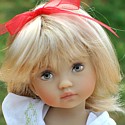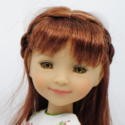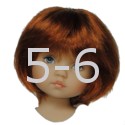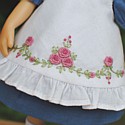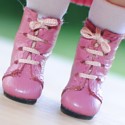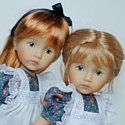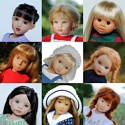No products
Clean and Care
Boneka products are manufactured with love and diligence.
So your enjoyment lasts a long time, we compiled a few information about care and cleaning of our products, general care instructions (also for other dolls and doll accessories) and a bit material science as well.
The following information does not lay any claim to being complete and only reflect our experience we made at Boneka during the last 30 years.
BONEKA EFFNER DOLLS
Our dolls are made of vinyl.
Vinyl is a synthetic material that contains so called plasticizers or flexibilizers which are needed to keep it smooth and avoids that vinyl becomes brittle and fragile at usual temperatures.
In the course of the years vinyl for doll production has continuously been developed and improved.
In the very beginning of using vinyl for many products there have been no long-term studies about how vinyl would change during the times. A lot of vintage dolls faded or became yellow or grey and/or brittle.
In addition to that the plasticizers support the absorption of colours during a longer period of time from material which is in direct contact with the vinyl. Therefore dolls can possibly be stained by coloured material.
For this reason we decided from the very beginning to wrap our dolls in unbleached paper that does not contain any colours or other aggressive chemicals. For a save transportation and storage we deliver the dolls in a batted fabric bag. The fabric is made of natural unbleached und uncoloured cotton.
The biggest “enemy” of vinyl dolls is direct sunlight.
For this reason vinyl dolls shouldn’t be disposed in the direct sun.
We recommend a shadowy and cool place.
When dolls are not displayed we recommend the storage in the original packing: our batted fabric bags. Add a little bag with dry lavender to keep unloved guests from the “wildlife” away. A sachet of silica gel is helpful to absorb moisture.
While playing and changing clothing please try not to touch the vinyl too often with bare hands. It is very natural that we have lipids and exfoliating skin cells on our hands which we transfer to everything we touch, even we have washed our hands. Dolls can develop a shimmery sheen from being touched too often with uncovered hands. If you like to play with your doll very often we recommend wearing cotton gloves.
Should your doll get little scratches despite of careful treatment, you can try to remove them carefully with sandpaper. In this case please use the smallest grit size of sandpaper. Please read more about sandpaper at Wikipedia
Please do not remove scratches on painted areas. You would remove the paint with this method.
To remove dust from our dolls (and even the best housewife can’t avoid dust) our dolls can be cleaned with a soft damp cloth with clear water. But please do not give them a full bath. Unlike us they wouldn’t enjoy it – stringing inside would possibly become wet and damage the doll.
Light soil can be removed with a little drop of dishwashing liquids on the damp cloth.
AT THE DOLL’S HAIRDRESSER: HAIR CARE
Doll wigs are made of various materials and need special care each.
In general light dusted hair can be combed out.
To keep the hair style in good condition you should use a hair net while storing the doll – especially curly hair tends to loose its shape.
To remove odour from wigs that can’t be washed you can treat them with freshly ground coffee powder. Coffee powder is binding odour and is also used for a fresh smell in the fridge. Put the coffee powder in a little fabric bag and put it together with the wig in a plastic bag for several days.
Human hair
Wigs with human hair can be treated with a soft shampoo and conditioner afterwards.
Curly hair will be destroyed by washing and needs to be done new with a hairdryer and round brush after washing. As a mini round brush for tiny curls I found out that a cleaned mascara brush is very handy.
Mohair
Mohair is very usable for braided hair styles but is very sensitive. A braided mohair wig that got out of shape must be combed and braided again. The new braids can be fixed with a very strong thread wrapped a few times around and knotted. Use a thread colour similar to the hair colour and the thread will be nearly invisible.
Washing real mohair wigs is not recommended.
Synthetic Mohair and Kanekalon
Thinking about doll hair you might think to wash it with shampoo in general – at least it is hair. But synthetic mohair and Kanekalon are synthetic fibres and shampoo has been developed for human hair with different properties compared to synthetic fibres.
For synthetic fibres you better use a soft colour detergents and a fabric softener afterwards.
Like temperature recommendations for your laundry made of synthetic fibres you should dry the hair with a hair dryer with low temperature or air-dry.
To avoid heating up the vinyl of your doll, put the wig on a wooden ball while drying with a hair dryer.
Rooted hair
Rooted hair can not be taken off the doll like a wig. In this case hair should be washed very carefully head down. Take care that no water sneaks into the doll thru the little holes in the head.
Dry the hair at low temperature with a hair dryer – or if you do not wish to use a hair dryer - comb the hair first and then hang the doll head down over the bath tub for air-dry.
Yellowed and faded hair
Vintage dolls often show yellowed and/or faded hair. Hair made from synthetic fibre can be dyed with fabric colour. Please be careful to not stain the doll with colour during the process of colouring. Follow the instructions of the manufacturer from the product you are using.
If all your lovable treatment was not helpful after all and the hair doesn’t want to become nice again it is time for a makeover. Then your doll deserves a new wig.
We offer WIGS in various sizes, styles and colours in our SHOP.
CLOTHING
During 25 years of Boneka Production we have neither heard of nor experienced staining to vinyl caused by our clothing.
Nevertheless we can not rule out that this might can happen. (never say never)
If you are concerned about any perceived risk, you may do the following:
a) handwash the clothes to see if the fabric dyes bleed out. You can fix colours by adding light vinegar to the water, or add a colour catcher to the laundry
b) dress dolls in white underwear such as knickers and tights, available in our shop in various sizes
Most of our clothes are made from natural fibre like cotton and linen and can be washed. Just follow the washing instructions for your laundry.
Not washable are our products made from woolfelt. Just take a soft brush to brush out dust. Be careful not to roughen the felt too much. Protruding fibres can carefully be cut back with a pair of small sharp scissors.
Following tips and tricks from my “washing laboratory” have been very helpful in the past:
If dyed fabrics bleed out, put a bit light vinegar into the water. The acid of vinegar binds colours.
Also Colour Catcher for the washing machine are binding colours and avoid that the colour which bleeds out into the washing water goes back into the fibres and dye the light parts of your clothing. Just throw one cloth into the washing machine. These colour catchers have been very helpful in the past. From my personal experience as a quilter I can tell: using them saved all of my quilt’s life until today.
Small spots can be treated with bile soap. Bile soap is a natural product without any aggressive chemicals and splits fat. Bile soap can be used for a variety of different spots caused by fat, blood, fruits and proteins.
Fresh blood stains can be removed by spitting on the spot. Really that is not a fairy tale. It is a proven method used by seamstresses since centuries. Spitting on a fresh blood spot in fabrics you can literally watch the spot going. Spit on it until the spot is invisible. Then wash with clear cold water.
Stains in white fabrics can be treated with Vanish Oxi Action, this product sets oxygen free. Also treatment with chlorine bleach can be helpful. Please do not use chlorine bleach on coloured fabric.
White washed laundry can be air-dried in the direct sunlight. Sunlight naturally bleaches white fabrics. For this reason this method has been used from washerwomen since centuries. And helped me in the past winning my “fight” against persistent carrot spots in my baby girl clothing
Rinse your laundry thoroughly with clear water. Please bear in mind that detergent residues will be in direct contact with your doll.
If the spot after all doesn’t want to leave your doll’s dress it’s time for a new outfit.
We offer a wide range of DOLL CLOTHING in our shop.
BONEKA LEATHER SHOES
Our DOLL SHOES are made from 100% genuine leather and can be treated and cleaned with usual leather care products. Anyway doll shoes are not heavily used because our dolls do not run around and play in their shoes.
A bit of colourless shoe polish will give back the original shimmer and smoothness to the leather and the shoe will look like new.
Our shoes are all carefully handmade and this gives people in Indonesia work and a good income. Nevertheless we are all humans and it might happen that a little bit of transparent glue is visible at the outside. This glue can be removed with an eraser. For this method please follow our VIDEO INSTRUCTION
Colourful leather shoes are made from dyed leather. Especially dark colours from coloured right through leather can dye into vinyl by and by at direct contact. For this reason we recommend to wear SOCKS or tights with the shoes. If you do not wish to wear socks e.g. with sandals please do so for a short period of time.
If you are concerned about stain please have a close look at your Boneka leather shoes. Often the leather is not coloured right through and the colour is only on the upper surface. Often the inside of the shoe is light and undyed.
We consider our light colours like e.g. colour numbers 000 (white) and 027 (light pink or peach) for harmless.
For stains in your vinyl doll caused by our shoes we do not take responsibility nor give any guarantee or assume any liability.













































